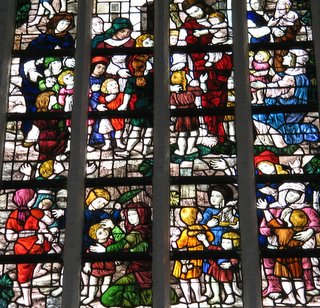
July 2005
St Francis of Assisi Parish Newsletter

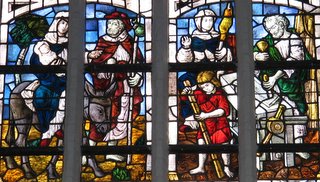
|
St Francis of Assisi
Anglican Church, 373 Milner Street, Waterkloof, 0181 Tel. 012-346 1106/7,
Fax: 346 4226. | ||||||||||||||||||||||||||||||||||||||||||||||||||||||||||||||||||||||||||||||||||||||||||||||||||||||||||||||||||||||||||||||||||||||
ForewordMany
thanks to all who have contributed to this Winter issue of The
Franciscan. I hope you’ll enjoy their articles and be inspired to
send us something for the next issue, which will be towards the end of the
year. This
is the first time the hard copy of the newsletter has been printed and not just
photocopied. All production and printing costs have been borne by the
printer, Dave Tweedley, to whom we are most grateful. The
stained glass windows above come from a church in Delft, Holland.
They depict (below) two scenes from the childhood of Jesus and (above) His
command ‘Suffer the little children to come unto me’. This command
evokes the work being done at the Lekgema Haven, Tumelong. Jill
Daugherty (Ed) From the Rector's DeskMy dear Parishioners, It’s
intriguing that we are often astonished at the things of God.
Perhaps it’s the implicit mistake we make of assuming that our
pilgrimage of faith is based on a relationship (with God) that is, when
all’s said and done, no different to any other relationship.
So when we get involved with this God, we expect it to mirror
willy-nilly our “earthly” relationships, for we always want thins to
be simple and easy to understand. I
think we need to be reminded that almighty God is like NO OTHER.
For starters, “God is three and God is One” that
in itself should tell us something startling. Yes
indeed, we are not dealing with a benevolent, mildly muddled favourite
uncle, whose only need is to be patted on the head from time to time.
A sort of gracious tolerance on our part.
Not only is such thinking untenable, but (what is worse) it is
limiting: if we insist on experiencing God in this way, we will remain
trapped in a limited relationship with Him and never move deeper into the
God who calls us to Himself. Modern
spiritual life all too easily lacks depth, possibly because of this
tendency to “familiarize” our knowledge and relationship with God.
I am well aware that we are indeed encouraged to call God
“Father” and this invites a wonderfully warm and close relationship
– but not at the expense of losing sight of God’s Otherness, God’s
Supreme Being. The moment we
expect our faith (and God) to be convenient, our pilgrimage is hampered
because at that point God ceases to be Other.
In effect, what we do therefore is to bring God DOWN TO OUR LEVEL
– and, let’s face it, that cannot be right. Incidentally,
I am not in any way trying to debunk traditional belief in a God who truly
became Incarnate, nor (for that matter) trying to rationalize away all
possibility of a subjective relationship with this God.
I am not a natural “postmodernist” creature.
My own faith is firmly based (without reservation) on Orthodoxy.
Jesus Christ is Lord and Saviour.
I believe He died an atoning death for my sins and that on the
third day He rose again. He
ascended into heaven where He assumed His rightful position within the
Mystical Union of the Blessed Trinity.
And I believe He will come again in great power and glory to judge
both the living and the dead. Furthermore,
I will lay down my life for my faith – though long may that moment be
away. None
of this, however, should lull me into the mistaken belief that my vigorous
commitment to strict orthodoxy means I lapse into naivety.
Reality dictates that we acknowledge that God is a BOUNDLESS
MYSTERY – and Holy Scripture affirms that.
Trevor Hudson points out, however, that “this does not mean that
He is a giant puzzle to be fathomed out”.
To say that God is a Mystery indicates that He is unlike anyone
else: “… there is no-one else like Him”.
There is a simple test for all this: the moment we assume we
have God all figured out – that is the moment we are further from the
Truth than we have ever been. To
be sure, most of us are not particularly “at ease” with the unfathomable – hence our predilection for dogma and the like.
This way, we control God.
He behaves according to our neat package of understanding.
I see two dangers in such thinking:
Let
us therefore be renewed in our commitment to this God who ALONE is God.
Who ALONE is both Lord and Saviour.
Who ALONE is supreme Other. And
in this commitment let us allow Him to reveal His majesty and Glory to us
as we bow before His Presence in awe and wonder. What
a Mighty God we serve!
Fr Timothy YOUR
WORDS COME TRUE
|
||||||||||||||||||||||||||||||||||||||||||||||||||||||||||||||||||||||||||||||||||||||||||||||||||||||||||||||||||||||||||||||||||||||
|
The
members of the Craft Group who meet on Thursday mornings are June
van der Merwe, Jocelyn Gioia, Innis Barnet, Hazel Thompson, Amy
Macnamara, Monica Botha, Margaret Rautenbach, Betty Pickard, Sonia
Sewell, Yvonne Merchant and Joy Hopking. |
|
|
What
is the Diocesan Children’s Ministry Board?
In
February 2004, Bishop Jo arranged a day at the Cathedral for all the
people involved in Sunday school or children’s ministry.
The aim was to get together and discuss the obstacles and struggles
that we face in the ministry.
As
a result of this morning together, the Children’s Ministry Board was
formed. There are between 12
and 15 of us who meet at regular intervals, with Mrs Phyllis Kraft as our
chairlady.
Over
the past year we have been meeting and discussing the needs and concerns
of all our teachers and working to arrive at the core issues. As a result, we have set up a two-year training programme.
Each Archdeaconry in the Diocese will have eight training sessions
during the two-year period. At the end of the training period, each person who has
completed the training will receive a Diocesan Certificate endorsed by the
Bishop. The idea behind this
is to ensure that all teachers and leaders of children in the Church are
equipped and empowered on the same level.
The
Archdeaconry of Pretoria East has completed two training days.
Each day starts with an in-depth Bible Study, a practical way of
showing the teachers how they can go about studying the passage they need
to put across to the children. And then for the second half of the morning we focus on
another key issue.
These
training days have proved to be invaluable, even for the “old hands”,
because we are reminded of things that we have forgotten, or get new ideas
from other parishes. It is
also a way of building unity within the Archdeaconry.
Please
pray for the work that the Board is doing through the Diocese.
God
Bless
The
word planet comes from a Greek word meaning “a wanderer”. The
ancients recognized seven “wandering” objects in the sky, namely the
sun, the moon, and the five planets that can be seen with the naked eye:
Mercury, Venus, Mars, Jupiter and Saturn. These objects were referred to
as wanderers because they move against the background of fixed stars.
These movements were measured and recorded in Mesopotamia at least 3 500
years ago. The seven wandering objects are responsible for an arbitrary
calendrical period – the seven-day week. (Other calendrical periods are
determined by a fixed period of time: a year is the time taken by the
Earth to orbit the sun, a month is based on the period from new moon to
new moon, and a day is the time the Earth takes to rotate once on its
axis.)
The
seven-day “planet” week comes to us from the Rome, where Sunday was dies
Solis; Monday dies Lunae; Tuesday dies Martis; Wednesday
dies Mercurii; Thursday dies Jovis; Friday dies Veneris;
and Saturday dies Saturnii. The celestial identities of the days of
the week are evident in the Romance languages of Europe, i.e. those
languages that derive from Latin. For example in French, Tuesday is mardi,
Wednesday is mercredi and Friday is vendredi. (Mardi gras
is Shrove Tuesday; gras means “fat” because people ate a
lot on that day, using up all the fat they had in the house before the
fasting of Lent).
In
English, the astronomical origin of the names of three days of the week is
clear – Sunday (for the sun), Monday (for the moon) and Saturday (for
Saturn). When the custom of the seven-day week was introduced into
northern Europe by the Romans, some equating of gods was done, and the
English names for the other days of the week were derived from the names
of the Anglo Saxon equivalents of the Roman gods.
Tuesday
is Tiwes Daeg (Tiw’s day). Tiw derives from Tyr, a Norse god
linked with war and leadership. Mars was equated to Tiw, because they were
both gods of war. The leader of the Norse gods, Odin, was known as Woden
to the Anglo Saxons. Woden was equated with Mercury rather than Jupiter,
as would be expected, because of Woden’s habit of working with good and
evil spirits in healing and divining. Wednesday is therefore Wodnes
Daeg. Thursday was named after Thor (Thunres daeg). Thor was
the Norse god of thunder, and his affiliation with storms caused him to be
equated with Jupiter. Venus was naturally equated with Odin’s wife,
Frig, the Norse goddess of fertility, women and love, and so Friday is Frig
daeg. Thus some English words for days of the week have their origin
in Germanic languages.
Although
Rome introduced the seven-day week to countries within its empire, it did
not invent it. The Chaldeans were the first to use it, assigning the names
of the Mesopotamian planet gods to the days of the week. Specific gods had
been assigned to the planets by the Mesopotamians at least as early as the
Akkadian period (2340BC - 2150 BC). The
Chaldeans introduced the seven-day week to the Mediterranean world around
200 BC and the Greeks equated their own gods to the Babylonian ones in
much the same way as the Romans were to do with the Germanic ones. For
example, the Babylonian god of fertility, Ishtar, became Aphrodite in
Greece and Venus in Rome.
Although
it is easy to equate the “wanderers” to the name of a
particular day, the current sequence of days at first seems
illogical. In Graeco-Roman
times, it was assumed that the Earth was at the centre of all things, and
that the “wanderers” were in orbit around it. The time taken for a
“wanderer” to complete a circuit of the zodiacal constellations, i.e.
the time taken for it to return to the same part of the sky, was regarded
as an indicator of its distance away from the Earth – the slower it was,
the further away it was. The series began with Saturn, which, because it
was the slowest mover, gave its name to Saturday, the day once regarded as
the beginning of the week. Saturn
takes 29 years to complete its orbit. The next slowest is Jupiter (12
years), followed by Mars (22 months), the sun (one year), Venus (10
months), Mercury (3 months), and the moon (one month). This should give
the days of the week in the order Saturday, Thursday, Tuesday, Sunday,
Friday, Wednesday and Monday!
The
possible explanation of the current order of the days of the week comes
from Greek astrology, wherein each hour of the 24 hours in a day
was ruled by one of the seven “wanderers”, in the same sequence as
above. Saturn ruled the first hour of Saturday, Jupiter ruled the second
hour, Mars the third and so on. In cycling through the hours of the day,
each of the seven planets would rule three times in 21 hours. The cycle
would start again for the three remaining hours, which would therefore be
ruled by Saturn, Jupiter and Mars, thus completing the 24 hours. The first
hour of the second day would be ruled by the next in order
after Mars, which is the sun, so this day, Sunday, followed Saturday. In
the same way, during Sunday, after 21 hours the cycle would be complete
and the last 3 hours would be ruled by the sun, Venus and Mercury
respectively. The first hour of the third day would be ruled by the
moon, so Monday followed Sunday and so on. Therefore the rule was that the
order of the days of the week was determined by which planet ruled the
first hour of a particular day. The 24-hour day is an Egyptian concept, so
it is thought that the scheme for the order of the days of the week was
devised in Alexandria in the second century BC.
Maybe
it is fortunate that Uranus, Neptune and Pluto had not been discovered at
this time, for we may then well have had a ten-day week to contend with!
The alternative view is that, if they had been discovered, with the three
extra days, we would have enough days in the week to get everything done.
Reference:
“Calendar Worlds” by E C Krupp, Sky & Telescope, January
2001, p 103
Michael
Poll
(Pretoria Centre, Astronomy Society of Southern Africa)
Important
Events for the rest of 2005
July
|
August
|
||
|
9 |
Quiet Morning (Christ Church) |
9 |
Women’s Day |
|
10 |
17:30 Lay Ministers Meeting |
14 |
17:30 Lay Ministers Meeting |
|
11
- 15 |
Holiday Club |
18 |
DFB & Trustees meetings |
|
25 |
18:00 Executive Meeting |
19 |
Chapter |
|
27 |
19:30
Parish Council Meeting |
20 |
DSC |
|
30 |
Mission Training |
22 |
18:00 Executive Meeting |
|
|
|
24 |
Clergy Day |
|
|
|
25 |
19:30
Parish Council Meeting |
|
|
|
27 |
Mission Training |
September
|
October
|
||
|
1-3 |
Synod |
4 |
St Francistide |
|
4 |
Diocesan Family Day |
6 |
Archdeaconry Council Meeting |
|
11
|
17:30 Lay Ministers Meeting |
9 |
18:00 Lay Ministers Meeting |
|
17 |
Archdeaconry Lay Ministers’ Forum |
19 |
Clergy Day |
|
16-18 |
? Family Encounter Weekend |
24 |
18:00 Executive Meeting |
|
18 |
Exam Service |
27 |
19:30 Parish Council Meeting |
|
22 |
Bishop’s Charity Golf Day |
|
|
|
24-31 |
Botswana Mission |
|
|
|
26 |
18:00 Executive Meeting |
|
|
|
29 |
19:30 Parish Council Meeting |
|
|
|
30 |
Pub Evening |
|
|
November
|
December
|
||
|
5 |
Rectors & Churchwardens Conf |
1 |
World AIDS day |
|
13 |
18:00 Lay Ministers Meeting |
1 |
19:30 Parish Council Meeting |
|
17
|
Trustees & DFB |
6 |
Chapter |
|
18 |
Chapter |
11 |
18:00 Lay Ministers Meeting |
|
19 |
DSC |
25 |
Christmas Day |
|
21-25 |
Clergy Retreat |
26 |
Parish Office closed till January |
|
25 |
Youth End Year Dance |
|
|
|
27 |
Advent |
|
|
|
28 |
18:00 Executive Meeting |
|
|
The Craft Group & Lekgema Haven
What is the Diocesan Children's Ministry Board
The Catacombs on the Island of Milos
Important Events for the Rest of 2005
(Grant Thistlewhite received the following e-mail from
a friend and would like to share it with us.)
A sobbing little girl stood
near a small church from which she had been turned away because it was
"too crowded".
"I can't go to Sunday
School," she sobbed to the pastor as he walked by.
Seeing her shabby, unkempt appearance, the pastor guessed the reason and,
taking her by the hand, took her inside and found a place for her in the
Sunday school class. The child was so happy that they found room for her,
and she went to bed that night thinking of the children who have no place
to worship Jesus.
Some two years later, this
child lay dead in one of the poor tenement buildings. Her parents called
for the kindhearted pastor who had befriended their daughter to handle the
final arrangements. As her poor little body was being moved, a worn and
crumpled red purse was found which seemed to have been rummaged from some
trash dump. Inside was found 57 cents and a note, scribbled in childish
handwriting, which read: "This is to help build the little church
bigger so more children can go to Sunday school".
For two years she had saved
for this offering of love. When
the pastor tearfully read that note, he knew instantly what he would do.
Carrying this note and the cracked, red pocketbook to the pulpit, he told
the story of her unselfish love and devotion. He challenged his deacons to
get busy and raise enough money for the larger building.
But the story does not end there...
A newspaper learned of the
story and published it. It was read by a wealthy realtor who offered the
church a parcel of land worth many thousands. When told that they could
not pay so much, he offered to sell it to the little church for 57 cents.
Church members made large
donations. Checks came from far and wide.
Within five years the little girl's gift had increased to $250,000.00 –
a huge sum for that time (near the turn of the century). Her unselfish
love had paid large dividends.
When you are in the city of
Philadelphia, look up Temple Baptist Church, with a seating capacity of
3,300. And be sure to visit Temple University, where thousands of students
are educated.
Have a look, too, at the Good
Samaritan Hospital and at a Sunday School building which houses hundreds
of beautiful children, built so that no child in the area will ever need
to be left outside during Sunday school time. In one of the rooms of this
building may be seen the picture of the sweet face of the little girl
whose 57 cents, so sacrificially saved, made such remarkable history.
Alongside of it is a portrait of her kind pastor, Dr. Russel H. Conwell,
author of the book Acres of Diamonds.
This is a true story, which goes to show WHAT GOD CAN DO WITH 57 CENTS.
11
July 2005
Dear
Father Tim,
Thank
you very much for your sermon yesterday. You mentioned that you wondered
how next to interpret the particular passage, so I thought the following
might be of use to you.
In
my view the same passage could be used to argue the approach to and
benefits of tithing:
o
Never giving to the
church and/or giving the bare minimum is like the seed on the rock – it
has little, if any, chance of bringing the desired results.
o
To stop giving when
times are perhaps somewhat hard or when other things enjoy priority is
like the seed in the thistles: growth and potential benefits are hampered
due to the unfriendly environment.
o
Giving with firm
conviction through thick and thin is like sowing in the fertile ground: it
will yield results, 30-fold or more, if given with the firm conviction
that it is the right thing to do. Results as far as what the parish will
be able to do and achieve will be quite amazing while the benefits for the
individuals will be far more than what they ever expected.
Perhaps
one should ask everyone to give it a try for a year or so and see for
themselves? Hope you will find this useful and thank you very much for the
good work you are doing!
Best
regards,

The Craft Group and Lekgema Haven
I
am overawed by the way the Lord uses “The Crafty Ladies” from our
church. Every year we step
out in faith to give the children at Lekgema Haven a party. This year,
having knitted them 60 jerseys, we decided to buy tracksuit pants to go
with the tops.
We
started off with R300 in our kitty and R500 from the raffle. (Sarah
Nkoana, my domestic worker, crocheted the four blankets that were
raffled.) We were told that there were 72 children at the Haven, but when
we inquired about the age groups it turned out that there were 102
children. Even though we had barely scraped through with the money for 72
children, we decided to step out in faith and provide for all 102
children.
Mrs
Rena du Toit of Moreleta Plaza Pep Stores donated quite a few garments and
sorted out garments that had been marked down in price. When news got
round about our venture, the money came in: one parishioner gave R500,
another R100, then R50, R30, R20, R15 – it all added up. Besides the
tracksuit pants, we bought sweets, biscuits, chips and cold drinks, which
we made up into packets for the children. We also bought fruit. There was
enough of everything for the children that go to the Haven after school to
enjoy as well.
When
we were at the fruit and veggie shop, a total stranger came up to Joe and
handed him a R100 note. I was so taken aback that I forgot to ask him his
name, I only hope that I did say thank you.
What
a blessing it has been for all who have been involved, in one way or
another. The caregivers at the Haven do so appreciate it when we take time
off to share just one day with them and see how wonderfully they care for
the children. They deserve more than just our gratitude.
We
came away feeling more blessed and enriched by our visit than the
children.
June van der Merwe
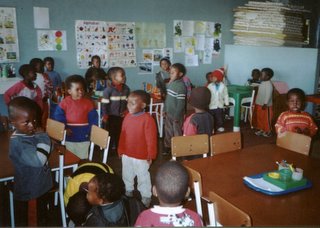
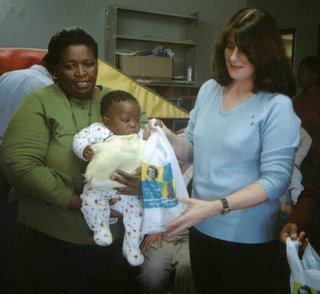

The
Catacombs on the Island of Milos
At
the end of May, a friend and I spent three days on Milos, one of the
Cyclades islands in the Aegean Sea. It is a volcanic island – volcanic
activity began there more than 2 million years ago and ceased 90 000 years
ago. Because of its geology, Milos is rich in minerals, which have been
mined for many centuries. Over the years various nations have conquered
the island in order to exploit this mineral wealth.
In
the 1st and 2nd centuries AD, the island was part of
the Roman Empire. Milos was one of the first of the Greek islands to be
Christianised, but the Roman rulers did not approve of this new religion.
The Christians (many of whom were miners) therefore constructed catacombs
in the soft pumice rock above the town of Klima. They excavated tunnels
and chambers in which they could take refuge, hold services and bury their
dead. The catacombs are among the most extensive in the world: there are
185 metres of tunnels and about 2 000 people were buried there in cavities
along the walls and in the floor.
The
catacombs have survived (the only ones to have done so in Greece) because
of earthquakes, which destroyed the ancient town of Klima and blocked the
entrances to the tunnels. The first major earthquake took place in the 5th
or 6th century AD. In the 18th century more
earthquakes forced the people to leave the coast and move to higher
ground: the towns of Plaka and Tripiti were established and Klima was
reduced to a small fishing village.
The
catacombs were rediscovered by chance in 1840. By this time Greece and its
islands had been freed from Turkish rule by the war of independence. But
before the authorities could secure the site for archaeologists, many of
the graves had been vandalised. Today the public is allowed to visit only
one of the chambers, accessed by a short tunnel. Other tunnels leading out
from this chamber are blocked off, as are other entrances. Nevertheless
one gets some idea of what it must have been like to hide underground and
worship in secret. The entrance is guarded, but there is no entrance fee
and visitors are allowed in without supervision. This helps retain the
mystery and sacred nature of the site, which is not reduced to a mere
tourist attraction.
To
get to the catacombs, we took the local bus from the port town of Adamas
where we were staying. The bus winds up the hill to Plaka and on to
Tripiti. Before reaching this town, we got off at a sign indicating the
road to the catacombs. This road zigzags down the hill towards Klima. Half
way down, steps have been built leading to the entrance of the catacombs.
Using these steps, one thinks of the early Christians who had no such aid
to reach their hideaway.
Back
up the steps and further down the hill, we found the old Roman theatre.
The stage is in ruins, but the seats that go up in tiers are remarkably
intact and invite one to sit and admire the view – the bay and the
passing ships.
In
the vicinity of the theatre is the cave that was discovered by a farmer in
1820 (when Milos was still ruled by the Turks). The hill is terraced to
make farming possible and digging into the side of the hill the farmer
uncovered a cave, inside of which he found some marble statues, in
particular one of a beautiful woman. It was decided that she represented
the Greek goddess of love and beauty, Aphrodite (Venus is her Roman name).
A French officer who was on the island alerted the French consul in
Istanbul about the find and he sent his secretary to buy the statue from
the farmer. This is why the Venus de Milo is now on display in the Louvre
in Paris. The archaeological museum in Plaka only has a copy.
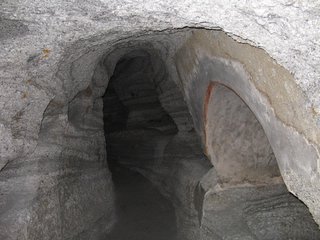
A tantalising view down one of the tunnels leading off the main chamber of the catacombs.
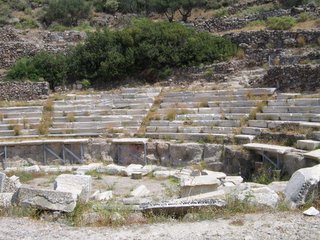
The old Roman theatre is below the catacombs.
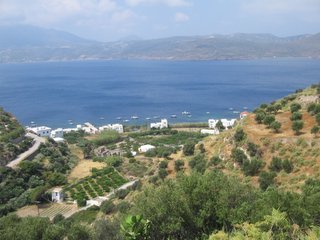
Modern Klima is a small town below the catacombs and the theatre.
|
Visit
these Internet sites for more pictures of the Island of Milos. |
Jill Daugherty
The
Bookstall is going to be replaced by a lending library.
We
appeal to every parishioner to donate at least one book to the library.
The books need to relate to matters spiritual.
No
Mills and Boon!